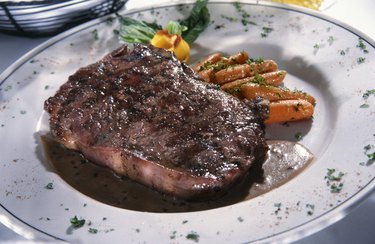
It's inevitable that meat shrinks when you cook it, but just how much it shrinks depends on a number of factors. If you're trying to figure out exactly how much raw beef you need for a dinner party or have another reason to be concerned with your final yield, it's safer to overestimate. While you can't completely avoid meat shrinking during cooking, certain steps minimize meat loss.
Shrinkage Amounts
Video of the Day
Meat can shrink by as little as 10 percent of its starting weight or by as much as 50 percent. The average loss is somewhere between 15 and 30 percent. So, if you're using a formula involving a specific weight per person, assume about a 30 percent loss in the total weight after cooking. Remember, though, that there's meat loss for other reasons, too. Are you buying bone-in cuts? There's also loss from fat trimming and carving, which can be considerable if done by an inexperienced hand.
Video of the Day
Why Shrinkage Occurs
Meat primarily shrinks and loses bulk because the juices inside move to the surface during cooking and drip out or evaporate. Also, collagen melts and fat renders, and weight is lost as these liquified components leak from the meat. These effects of cooking kick in most substantially when the internal temperature of the meat reaches 140 degrees Fahrenheit, accelerating from there as the temperature rises.
Temperature Considerations
Cooking at lower temperatures minimizes shrinkage. The internal temperature of the meat also has an important role. The shorter the cooking time, the less loss. Cooking meat past medium, or 140 F, results in the most significant reduction in weight and size. Also, keep in mind that cooking multiple cuts of meat at the same time, especially in an oven, necessitates longer cooking time, and therefore results in more loss.
Keeping Meat Moist
Steps to keep the meat's internal juices in place help minimize size and weight loss, too. Keeping meat between rare and medium is a good start. Refrain from salting your meat before cooking, or at least go light with the salt because it draws moisture to the surface. A cooking method using liquids, such as braising, frying or roasting, helps keep meat more moist, as well, while dry methods, like grilling, baking and broiling, tend to lead to more shrinkage. Also, be careful not to pierce meat before or during cooking, as juices escape through punctures. For example, flip a steak with tongs or a spatula, not by impaling it on a large fork.